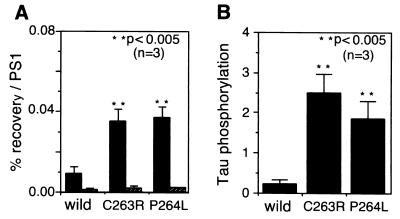Figure 5.
Effect of PS1 mutants on tau phosphorylation. (A) Constructs coding for FAD-associated mutant forms of PS1 was transfected into COS-7 cells. Ten percent of each lysate was used for immunoblotting with MKAD3.4, and the remainder of each lysate was used for analyzing the coimmunoprecipitation of GSK-3β with PS1, using MKAD3.4. Constructs coding for four repeat tau and FAD-associated mutant forms of PS1 were cotransfected into COS-7 cells. Each lysate was then immunoprecipitated by using MKAD3.4 and immunoblotted by using anti-tau antibody (JM). Recovery of GSK-3β (closed bar) and tau (striped bar) is presented as the percentage (%) of recovery normalized to the corresponding expression levels of PS1 (mean ± SD; n = 3). The lower percentage recovery/PS1 on tau is because of underestimation of the cotransfection results. ∗∗, P < 0.005 (two-tailed t test). (B) Constructs coding for four repeat tau and FAD-associated mutant forms of PS1 were cotransfected into COS-7 cells. Each lysate (30 μg) was then immunoblotted by using the phosphorylation-dependent antibody (PS199). The immunoreactive bands were quantified with a Lumino-CCD Densitograph (Atto). The level of tau phosphorylation is presented as mean ± SD (n = 3), ∗∗, P < 0.005 (two-tailed t test).

